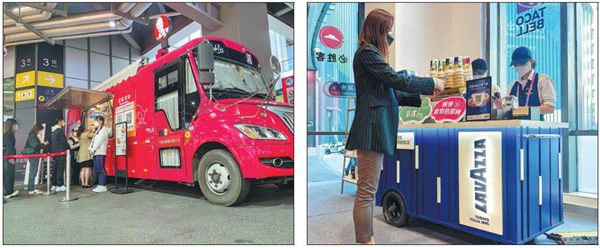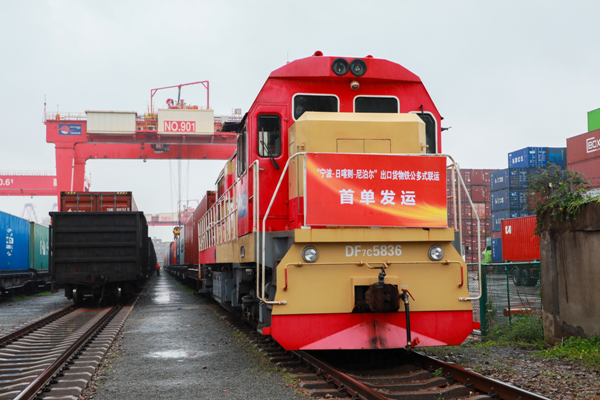Foreign caterers eager to invest in nation
Companies continue expansion plans despite challenges posed by pandemic

From left: Customers are served at KFC's mobile dining car (left) and Lavazza's coffee booth at this year's China International Import Expo in Shanghai. [Photos provided to China Daily]
Global coffee chain giant Starbucks recently opened its second intangible cultural heritage concept store in China in the Shenyuli area of Shanghai.
The store is housed in one of the best-preserved buildings in the city to feature the Shikumen architectural style, which combines Western and Chinese elements and first appeared in the 1860s.
On entering the store, the most eye-catching features are 10 large handcrafted "coffee flowers "adorned with delicate red berries. The artwork was made by embroiderers in Suzhou, Jiangsu province.
The store also houses an exquisitely embroidered cheongsam from Shanghai, silverware from Heqing, Yunnan province, and tinware from Honghe, also in Yunnan.
The branch is one of Starbucks'1,000 outlets in Shanghai, The company, which has 6,000 stores in China, plans to increase the number of its branches nationwide by 50 percent to 9,000 in 300 cities by 2025.
This goal would see Starbucks opening one new store nearly every nine hours in China for the next three years. During this time, Canadian coffee chain Tim Hortons plans to expand rapidly in the nation — opening one new store every 12 hours.
Despite challenges posed by the COVID-19 pandemic, foreign catering companies are continuing to invest and expand in China, from constructing supply centers to developing digitalization and deliveries.
These companies also attract investment, and they are collaborating with Chinese partners to help spread Chinese culture and help the nation achieve its green goals.
At the China International Import Expo, or CIIE, in Shanghai this month, fast food chain KFC's mobile dining car was driven onto the exhibition site for the fifth consecutive year. Food produced in the vehicle was viewed by visitors through a large window.
Since first arriving in the Qianmen area of Beijing in 1987, KFC has opened 8,600 stores across China, launching some 500 new outlets nationwide in the first nine months of this year.
Joey Wat, CEO of Yum China, which manages KFC and Pizza Hut in China, said at CIIE, "As the first foreign catering chain enterprise to enter the country, Yum China is fortunate to have experienced China's reform and opening-up, which has brought extraordinary development opportunities in this massive market for 35 years."
As of September, Yum China owned 12,409 restaurants in 1,700 cities and towns across the country. The company plans to expand 1,000 to 1,200 of its stores in China by the end of this year.
During the pandemic, the fast development of digitalization and takeaway services has helped the company deal with the challenges it faces.
As of September, KFC and Pizza Hut had a combined membership program of more than 400 million customers, with digital orders accounting for about 91 percent of the two brands' revenue. Yum China plans to invest $1 billion to $1.5 billion on digital infrastructure in the next five years.
The company's artificial intelligence planning system not only enables riders to deliver across business districts, but also for its employees to achieve flexible scheduling across cities and regions.
By the third quarter of this year, KFC and Pizza Hut's takeaway sales accounted for 37 percent and 41 percent respectively of their overall revenue.
With more customers, especially the younger generation, looking for convenient readily prepared dishes during the pandemic, Yum China launched precooked food products in 2020.
In two years, KFC has attracted countless customers with its new packaged products, which include steak, fried rice and chicken soup, as well as microwaved dumplings, coffee and snacks. In the second quarter of this year, sales of these products reached 200 million yuan ($28 million), more than double the total for the same period last year.
Supporting role
Wolfgang's Steakhouse provides Chinese diners with top-quality steak from the United States. [Photo provided to China Daily]
In July, construction started in Jiading district, Shanghai, on Yum China's supply chain management center, the company's largest greenfield supply chain center project to date. The 61,000-square-meter facility — scheduled for completion in 2024 — will serve as the headquarters for supply chain operations.
Wat said: "Our world-class supply chain is one of our key business enablers, and has helped us mitigate the disruption brought by COVID-19. As our supply chain capabilities go from strength to strength, we believe the center will better support more stores, sales channels and products, while helping drive long-term growth."
As of the end of March, Yum China had 32 logistics centers. It plans to expand its logistics network to 45 to 50 centers over the next five years.
As part of its goal to achieve net-zero value chain greenhouse gas emissions by 2050, Yum China launched KFC's first green pioneer stores in Beijing and Hangzhou, capital of Zhejiang province, in April.
Wat said: "We are committed to driving meaningful change and steering the restaurant industry toward net-zero emissions. We will continue to explore the use of innovative technologies in restaurant construction and operations to promote sustainable development and contribute to the low-carbon economy."
In addition to fast-food chains, high-end restaurants are setting foot in China to meet local customers' rising demands for fine dining and service.
This month, luxury brand Louis Vuitton opened The Hall restaurant in Chengdu, the Sichuan provincial capital — its third restaurant globally. The others are in Paris and Tokyo.
Meanwhile, Wolfgang's Steakhouse from New York is opening a branch in Shanghai, its sixth on the Chinese mainland.
Peter Zwiener, who owns Wolfgang's Steakhouse, has flown to China several times in the past three years to check on his stores as business expands. He inspects each of his 35 outlets worldwide to ensure that they operate on the same level.
"China is growing rapidly. We opened in Shanghai, then Beijing, Shenzhen and Hangzhou. We want to be in all the nation's major cities," he said.
Zwiener said the pandemic has changed the entire catering industry, and in addition to food being served in the restaurant, he has to consider how to bring food to customers at home. One of his solutions is the takeout market.
"It's harder for high-end restaurants to do deliveries. You must make sure the packaging is correct, and you have to rely on the riders to deliver the food quickly and to avoid it being shaken too much during transit," he said.
Besides launching deliveries, the business uses a trailer in Beijing as a portable kitchen to cook its steaks.
"We're collaborating extensively with other partners such as high-end hotels, where we can perhaps open a pop-up on weekends, or we could maybe take over part of their kitchen," Zweiner said, adding that the portable kitchen will enable the business to join many outdoor events.
He also plans to take the portable kitchen to a city where the business doesn't yet have a restaurant.
Zweiner said more Chinese customers are enjoying top-quality steak, and Wolfgang Steakhouse's best-selling steak worldwide is the porterhouse, which is also a popular choice in China.
"A porterhouse is too big for one person, so we slice it so that more diners can share it. Such sharing is really suitable for Chinese customers," he said.
The business also has a wide range of wine and whiskey to pair with steaks, and Zwiener said Chinese customers are highly knowledgeable about wine and have sophisticated tastes.
The company's new branch in Shanghai is set to open in April, and Zwiener is already looking to expand in Chengdu, Suzhou and Nanjing, capital of Jiangsu.
He doesn't think that the pandemic will change his plans in China. "People have to eat, and eventually this coronavirus will go away one day," he said.
Coffee fever
The first Tim Hortons store in Yangzhou, Jiangsu province, opens this month. [Photo provided to China Daily]
According to the 2022 China Coffee Consumption Insight Report released by the food delivery platform Meituan in July, the market size of the made-on-site coffee industry in China was 8.97 billion yuan in 2021, a year-on-year rise of nearly 42 percent, and it is expected to reach 15.79 billion yuan in 2023.
Lu Yongchen, CEO of Tim Hortons China, senses that the Chinese coffee market is developing rapidly. "I think that with the increasing demand from Chinese consumers, this market will be more vigorous," he said.
He said about 200 to 300 cups of coffee per capita are drunk annually in the United States and Europe, but the corresponding figure for China is about 10 cups. "With consumption habits changing, the latter number will rise from 10 to 100," he added.
Since opening its first branch in Shanghai in 2019, Tim Hortons has launched more than 500 stores in some 30 Chinese cities.
"We initially opened our stores in first-tier cities, as they have a large population base and a more mature coffee consumption market," Lu said.
Taking Shanghai as an example, he said that as of June 30, there were 7,857 cafes in the metropolis, making Shanghai the city with the most cafes in the world, with 3.16 per 10,000 people.
"This situation is quite favorable for us, so we have more than 200 stores in Shanghai," he said, adding that the city's coffee consumption atmosphere is more personalized and diversified than elsewhere, as it includes major brands and independent cafes.
"We are also expanding to third- and fourth-tier cities. In the second quarter, we temporarily slowed the pace of expansion due to the pandemic, but since August, we have stepped it up by opening stores in many cities, including Jinan, Jiaxing, Wuxi, Yangzhou and Zhuhai," Lu said.
By the end of 2025, Tim Hortons' China unit plans to have opened 2,750 stores in the nation, according to Lu.
Tim Hortons' Chinese business went public on the Nasdaq Composite Index in the US at the end of September. Lu said that since entering China in 2019, the company has attracted several rounds of investment from enterprises such as Tencent, Sequoia Capital and Eastern Bell Capital.
"We achieved revenue of 404 million yuan in the first half of this year, a rise of more than 70 percent year-on-year. Despite the strong impact of the pandemic in the first six months, revenue growth remained strong," he said.
Collaboration is one of the ways in which Tim Hortons reaches targeted customers. In August, it opened Tims x Easy Joy cafe in Beijing with Easy Joy coffee. Since 2020, the Canadian chain has collaborated with Tencent E-sports to open co-branded coffee stores in Shanghai and Shenzhen, Guangdong province, providing a new experience for gaming fans.
Ready-to-drink coffee products in velvet coco and chestnut flavors will be jointly launched by Tim Hortons and Freshippo next month for sale at the grocery chain's 300-plus stores.
Lu said, "Our co-branded coffee products will fully exploit the dual advantages of our high-quality products and Freshippo's multiple sales channels to serve a wide range of consumer groups."
Special system
Li Xiaowei (left) hosts an event at Starbucks' first intangible cultural heritage concept store in China, located in Chaoyang district, Beijing. [Photo provided to China Daily]
Starbucks also plans to launch more special stores during its rapid expansion in China. This month in Xiamen, Fujian province, it opened its twelfth sign language outlet. This store has 15 employees — eight of whom have hearing difficulties.
Customers place orders by using a specially designed system that converts voice and text to achieve barrier-free two-way communication through a voice recognition assistant. Orders are also displayed on a double-sided screen for customers and hearing-impaired staff members.
This month marks the one-year anniversary of Starbucks' first intangible cultural heritage concept store in China, which opened in the Huamao area of Chaoyang district, Beijing.
Li Xiaowei, 31, who manages the store and has worked there since its decoration phase, has organized more than 50 events during the past year.
"We hosted eight batik workshops led by the inheritor of batik intangible cultural heritage from Danzhai county, Guizhou province, at which hundreds of customers got to experience this dyeing technique," Li said.
Each day when he arrives at the store, after donning an indigo-blue batik apron Li checks all 60 batik works in the building. He also knows the stories behind each of them.
"The difference between batik and tie-dyeing skills is the tools. The former uses a knife and wax, while the latter uses ropes," Li said, adding that he has been asked about this difference countless times during the past year.
A group of students majoring in art history at Communication University of China, who were curious over the batik canvas in the store's bar, asked Li a series of questions about the work. "They told me the experience they gained gave them new inspiration for their graduation designs," he said.
Li is happy to pass on his knowledge of intangible cultural heritage to colleagues as Starbucks opens more concept stores.
Starbucks, which aims to have 9,000 stores in China, is hiring 35,000 more staff members, and plans to double its sales and quadruple its operating income by 2025. It also plans to have 170 million registered members by 2025, up from the current 85 million.
Belinda Wong, chairwoman and CEO of Starbucks China, said during this year's CIIE: "China is an open and inclusive market. The dynamism and opportunities in China have greatly benefited Starbucks' development in the market."
In the next three years, Starbucks China will invest $220 million to launch its digital technology innovation center in the nation.
"We will continue to increase our investment while deepening our connections to China and supporting the industry's sustainable development through supply chain localization and digitalization," Wong said.

 China makes outstanding contributions to global energy transition
China makes outstanding contributions to global energy transition  Ningbo village inspires Malawi official
Ningbo village inspires Malawi official  A look at China's economic data in the first three quarters of 2024
A look at China's economic data in the first three quarters of 2024 


